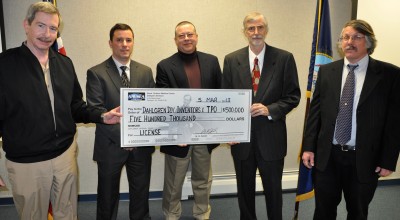
Naval Surface Warfare Center Dahlgren Division Commander Capt. Michael Smith and four NSWCDD inventors hold a symbolic check representing $500,000 in exclusive patent licensing fees at a March 5 ceremony. NSWCDD received $100,000 per patent – the largest upfront fees in the Navy's history – from Kismet Mgmt Fund LLC, for the licensing of five patents. The employee-inventors (left to right) Larry Fontenot, Danny Synan, Mike Masters (ret.) and Paul Werme were joined by their family members and command leadership at the event. Lonnie Welch, a Ohio University professor named as a co-inventor of all five patents, was not in attendance. U.S. Navy photo by John Joyce (Released).
DAHLGREN, Va.—A private company paid the Navy a record breaking $500,000 in exclusive patent licensing fees, Naval Surface Warfare Center Dahlgren Division (NSWCDD) Commander Capt. Michael Smith announced at a March 5 ceremony held here to honor the patents' inventors.
The Navy received $100,000 per patent - the largest upfront fees in the service's history - from Kismet Mgmt Fund LLC, for the licensing of five patents invented by four NSWCDD employees and a civilian university professor.
"This historic licensing agreement with private industry is a direct result of our employee-inventor's genius in developing technological solutions to challenges facing our warfighters and the Fleet," said Smith. "These five inventions will further benefit the warfighter as we roll the upfront fees into the research and development of new technologies to increase the safety of our Fleet and forward-deployed warfighters."
Although the license is exclusive, it applies strictly to the commercial sector. The Navy owns the patents and can allow non-profit institutions to use them for research.
"We have a responsibility to protect the government's intellectual property generated during the research and development process," said NSWCDD Chief Technology Officer June Drake. "In order to protect our intellectual property, we maintain a rigorous patent program. Technical transfer of these patents into the public domain can help the Navy save money by reducing cost and increasing product availability."
The patents' technical transfer can also result in royalty income for the Navy.
If commercial product sales are made that include these patents in the future, a percentage of those sales will also come back to NSWCDD in the form of royalties.
What's more, the technical transfer process enables the joint services to reward their researchers through licensing agreements.
"It results in a win-win situation all around for our employees, the Navy and most importantly, the warfighter," said Drake.
The inventors will receive $130,400 - about 26% of the licensing fee - based on an Office of Naval Research formula. NSWCDD will apply the remaining $369,600 to fund various licensing activities and research to develop more licensable technologies.
Interestingly, the five NSWCDD inventions are not new patents. The technologies were developed over the last 13 years with the earliest patent issued in May 2006.
"By its very nature performing research and development leads to some technologies being left on the shelf," explained Lorraine Kaczor, NSWCDD Technical Partnering Office Domestic Outreach Lead. "Licensing these technologies to business partners gives them new life to find their place in commercially available products."
Navy technologies can benefit from licensing since the commercial products they are incorporated into are typically less expensive and more available to the military.
"In the final analysis, this benefits the warfighter," said Kaczor. "Our command's investments in these patents are a testament to our commitment in research and development."
All five patents directly impacted the development of NSWCDD's Computing Resource Management software architecture capabilities in support of the High Performance Distributed Computing project or HiPer-D.
HiPer-D resource management architecture provides capabilities for real-time monitoring of computers, networks, and software applications within a distributed computing environment in addition to capabilities for starting and moving software components that adapt to performance bottlenecks and maintain system performance goals.
The architecture's key feature is the ability to monitor system performance coupled with the ability to dynamically allocate and reallocate system resources as needed.
The HiPer-D technology - jointly funded by the Defense Advanced Research Projects Agency DARPA and the USS Arleigh Burke (DDG-51 ship class) acquisition program - was never fielded by the Navy although it was assessed for possible use both within the Aegis Ballistic Missile Defense program and the future USS Zumwalt (DDG-1000 class guided missile destroyers).
Four NSWCDD inventors - Paul Werme, Larry Fontenot, Danny Synan and Mike Masters (retired) - were joined by their family members and command leadership at the event. Lonnie Welch - a Ohio University professor named as a co-inventor of all five patents, was not in attendance.
The five patents, registered in the U.S. Patent and Trademark Office Federal Register, follow: U.S. Patent No. 7552438 - Resource management device; U.S. Patent No. 7051098 - System for monitoring and reporting performance of hosts and applications and selectively configuring applications in a resource managed system; U.S. Patent No. 7096248 - Program control for resource management architecture and corresponding programs; U.S. Patent No. 7171654 - System specification language for resource management architecture and corresponding programs therefore; U.S. Patent No. 7181743 - Resource allocation decision function for resource management architecture and corresponding programs.


